This article was co-authored by Tu Anh Vu, DMD and by wikiHow staff writer, Hunter Rising. Dr. Tu Anh Vu is a board certified dentist who runs her private practice, Tu's Dental, in Brooklyn, New York. Dr. Vu helps adults and kids of all ages get over their anxiety with dental phobia. Dr. Vu has conducted research related to finding the cure for Kaposi Sarcoma cancer and has presented her research at the Hinman Meeting in Memphis. She received her undergraduate degree from Bryn Mawr College and a DMD from the University of Pennsylvania School of Dental Medicine.
There are 15 references cited in this article, which can be found at the bottom of the page.
wikiHow marks an article as reader-approved once it receives enough positive feedback. This article has 12 testimonials from our readers, earning it our reader-approved status.
This article has been viewed 815,531 times.
Food stuck in your teeth? Bad breath? Dentist asked the last time you flossed? No matter what brought you here, flossing your teeth is the perfect way to keep your gums healthy, and it’s such an easy addition to your daily routine. Even if you’ve never flossed before, we have you covered! We’ll walk you through the best way to floss as well as some tricks and alternatives you can try so your teeth look and feel great.
Things You Should Know
- Use a 18–24 in (46–61 cm) piece of dental floss and wrap it around your fingers. Pull a 1 in (2.5 cm) section taut.
- Work the floss between your teeth with a gentle back-and-forth motion. Guide the floss up to your gum line.
- Pull the floss tight against the side of your tooth. Rub between your gums and your tooth with floss using 8–10 strokes.
- Floss your teeth once daily before you brush your teeth to remove the most plaque.
Steps
How to Use Dental Floss
-
1Wrap 18–24 in (46–61 cm) of floss around your middle fingers. Tear off a long strand of floss so it’s easier to grip. Wind the ends of the floss around your middle fingers, but not so tightly that it digs into your skin or cuts off circulation. Leave a few inches of the floss unwrapped between your fingers.[1]
- Look for the American Dental Association (ADA) logo on the packaging when you’re choosing dental floss to ensure it’s safe to use.
- It’s okay if you accidentally use a shorter piece of floss, but it may be a little tougher to hold onto when you floss your back teeth.
- Wash your hands before you start flossing so germs and bacteria don’t get in your mouth.
-
2Hold a 1 in (2.5 cm) section taut with your index fingers and thumbs. Pinch the floss with your fingers and pull it tight so there isn’t any slack. That way, you’ll have a lot easier time getting it between your teeth.[2]
- Use a length of floss that’s easy for you to maneuver in your mouth. If you have a hard time flossing with a 1 in (2.5 cm) section, then try pulling 2–3 inches (5.1–7.6 cm) of floss taut instead.
Advertisement -
3Slide the floss between your teeth with back-and-forth motions. Start with your top front teeth since they’re the easiest to reach. Use a gentle rocking motion to guide the floss into the gap between your teeth, and slowly move the floss up towards your gums.[3]
- Be careful not to forcefully push the floss up since you could hurt your gums or make them bleed.
-
4Curve the floss into a C-shape around the base of your tooth. Pull the floss so it presses tightly against the side of your tooth. This helps you scrape the most plaque and buildup stuck to your tooth so you can get them clean.[4] Gently move the floss up further toward your gum line as far as you comfortably can go.[5]
- Avoid pushing the floss into your gums so far that it hurts.
-
5Rub the dental floss between your tooth and your gums. Floss the tooth on one side before you clean the tooth on the other side.[6] Work the floss gently between your gums and your tooth to break apart the buildup. Use 8–10 back-and-forth strokes to completely scrape off the plaque. Rub the floss against the side of your tooth as well. When you’re finished cleaning the sides of both teeth, slowly pull the floss out from between them.[7]
- If you haven’t flossed in a while, it’s completely normal for your gums to bleed a little bit. After a few days of consistent flossing, the bleeding will go away.[8] If you’re still bleeding after 3–5 days of flossing, talk to a dentist to see if you’re dealing with any other gum issues.[9]
- If you can still feel food or debris stuck between your teeth, switch to a fresh section of floss and clean that area again.
-
6Use a new section of floss between each of your teeth. Wrap the section of floss you just used around your middle finger and pinch a clean 1 in (2.5 cm) section between your fingers. Floss between all of your top teeth before moving onto your bottom teeth. Make sure you loop the floss around the backs of your rear molars to clean them too.[10]
- If you have trouble reaching the teeth in the back of your mouth, secure your floss into a floss holder. Hold onto the handle so you can reach your molars.
- Follow the same pattern each time you floss your teeth to make sure you don’t miss any spots.
- When you finish flossing, ball it up and toss it in the trash.
Flossing with Braces
-
1Use waxed floss to prevent it from breaking or tangling. Waxed floss has a coating that makes it easier to slide between the tight spaces between your braces and teeth. It also doesn’t shred as easily against the metal brackets or bands, so it won’t fray when you’re flossing between your braces.[11]
-
2Thread the floss behind the wires of your braces. Stand in front of a mirror so it’s easier to see what you’re doing. Guide the end of your floss under your brace’s wire between your 2 front teeth. Once you pull the floss through, gently guide it between your teeth and rub it back and forth to remove plaque or leftover food debris.[12]
- If you have trouble slipping the floss between the wire and your teeth, loop it through a floss threader first. Then, feed the floss threader under the wire and pull it through with the floss.
- If you can’t get standard floss between your teeth, try using an orthodontic flosser that has a narrow tip on the end. Guide the tip under your braces wire to remove plaque and food debris.
- After you finish flossing, brush your teeth to clean off any plaque you loosened up.
Expert Q&A
Did you know you can get premium answers for this article?
Unlock premium answers by supporting wikiHow
-
QuestionWhat does bleeding while flossing mean?
 Tu Anh Vu, DMDDr. Tu Anh Vu is a board certified dentist who runs her private practice, Tu's Dental, in Brooklyn, New York. Dr. Vu helps adults and kids of all ages get over their anxiety with dental phobia. Dr. Vu has conducted research related to finding the cure for Kaposi Sarcoma cancer and has presented her research at the Hinman Meeting in Memphis. She received her undergraduate degree from Bryn Mawr College and a DMD from the University of Pennsylvania School of Dental Medicine.
Tu Anh Vu, DMDDr. Tu Anh Vu is a board certified dentist who runs her private practice, Tu's Dental, in Brooklyn, New York. Dr. Vu helps adults and kids of all ages get over their anxiety with dental phobia. Dr. Vu has conducted research related to finding the cure for Kaposi Sarcoma cancer and has presented her research at the Hinman Meeting in Memphis. She received her undergraduate degree from Bryn Mawr College and a DMD from the University of Pennsylvania School of Dental Medicine.
Board Certified Dentist
-
QuestionDo I floss up and down or side to side?
 Cristian Macau, DDSDr. Macau is an oral surgeon, periodontist, and aesthetician at Favero Dental Clinic in London. He received his DDS from Carol Davila University of Medicine in 2015.
Cristian Macau, DDSDr. Macau is an oral surgeon, periodontist, and aesthetician at Favero Dental Clinic in London. He received his DDS from Carol Davila University of Medicine in 2015.
Doctor of Dental Surgery
-
QuestionWhat are some mistakes people make when they're flossing?
 Tu Anh Vu, DMDDr. Tu Anh Vu is a board certified dentist who runs her private practice, Tu's Dental, in Brooklyn, New York. Dr. Vu helps adults and kids of all ages get over their anxiety with dental phobia. Dr. Vu has conducted research related to finding the cure for Kaposi Sarcoma cancer and has presented her research at the Hinman Meeting in Memphis. She received her undergraduate degree from Bryn Mawr College and a DMD from the University of Pennsylvania School of Dental Medicine.
Tu Anh Vu, DMDDr. Tu Anh Vu is a board certified dentist who runs her private practice, Tu's Dental, in Brooklyn, New York. Dr. Vu helps adults and kids of all ages get over their anxiety with dental phobia. Dr. Vu has conducted research related to finding the cure for Kaposi Sarcoma cancer and has presented her research at the Hinman Meeting in Memphis. She received her undergraduate degree from Bryn Mawr College and a DMD from the University of Pennsylvania School of Dental Medicine.
Board Certified Dentist
Warnings
- It’s okay if your gums bleed a little when you first start flossing. However, contact your dentist if your gums still bleed after you floss for 3–5 days since it may be a sign you have an oral infection that requires medication.[20]⧼thumbs_response⧽
References
- ↑ https://dhss.delaware.gov/dph/files/flossingyourteethpi.pdf
- ↑ https://www.nhs.uk/common-health-questions/dental-health/why-should-i-use-dental-floss/
- ↑ https://www.nidcr.nih.gov/sites/default/files/2018-08/Flossing-508.pdf
- ↑ https://www.cda-adc.ca/en/oral_health/cfyt/dental_care/flossing_brushing.asp
- ↑ Tu Anh Vu, DMD. Dentist. Personal interview. 7 May 2020.
- ↑ Tu Anh Vu, DMD. Dentist. Personal interview. 7 May 2020.
- ↑ https://www.nhs.uk/live-well/healthy-teeth-and-gums/how-to-keep-your-teeth-clean/
- ↑ Tu Anh Vu, DMD. Dentist. Personal interview. 7 May 2020.
- ↑ https://medlineplus.gov/ency/article/003062.htm
- ↑ https://www.nidcr.nih.gov/sites/default/files/2018-08/Flossing-508.pdf
- ↑ https://www.nj.gov/health/fhs/oral/documents/miles_of_smiles_10-11.pdf
- ↑ https://www.comptonfamilydentistryga.com/client/images/postop-braces.pdf
- ↑ https://dhss.delaware.gov/dph/files/flossingyourteethpi.pdf
- ↑ https://www.nhs.uk/live-well/healthy-teeth-and-gums/how-to-keep-your-teeth-clean/
- ↑ https://www.adha.org/resources-docs/7123_Waterpik_Irrigation.pdf
- ↑ https://www.mayoclinic.org/healthy-lifestyle/adult-health/expert-answers/dental-floss/faq-20058112
- ↑ https://pubmed.ncbi.nlm.nih.gov/29741239/
- ↑ https://www.ada.org/resources/research/science-and-research-institute/oral-health-topics/floss
- ↑ https://www.ncbi.nlm.nih.gov/pubmed/19776569
- ↑ http://www.nlm.nih.gov/medlineplus/ency/article/003062.htm
About This Article
Step 1: Wrap the ends of the floss around your middle fingers to hold it in place.
Step 2: Hold the floss between your thumbs and index fingers.
Step 3: Slide the middle of the floss between 2 of your teeth.
Step 4: Move the floss up and down and back and forth to clear away all of the plaque and debris.
Step 5: Repeat with all of your teeth.
Step 6: Rinse your mouth out with water or mouthwash.
Step 7: Repeat daily.


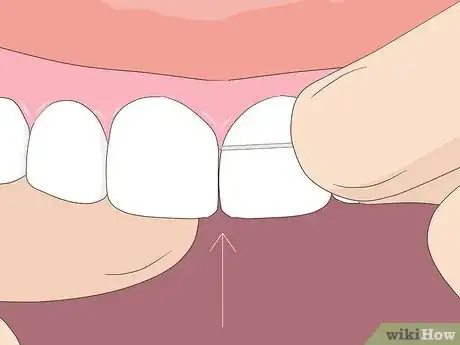




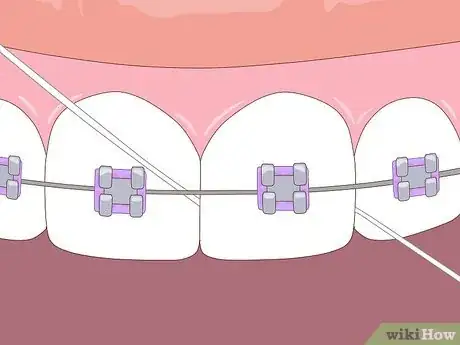
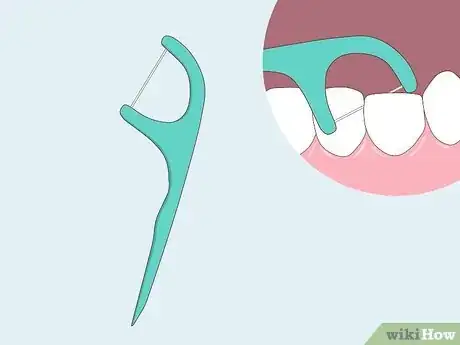
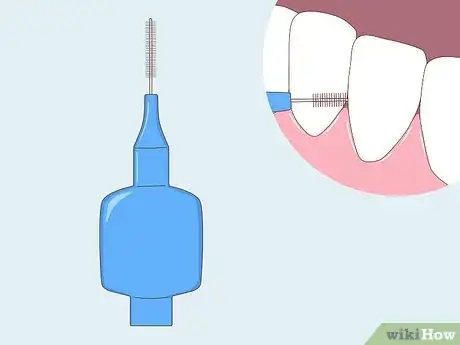
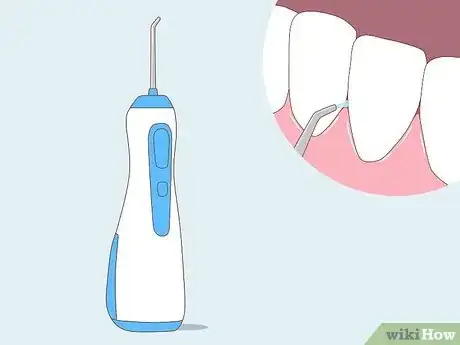
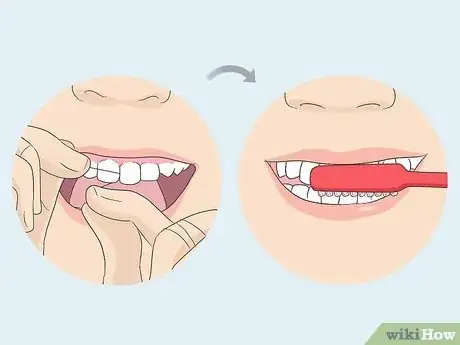

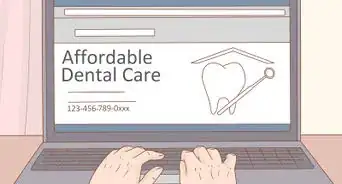
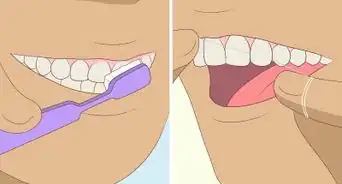


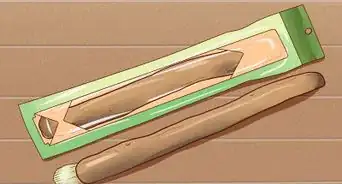
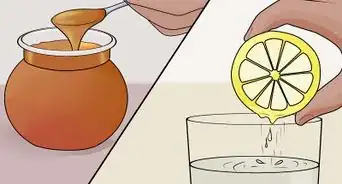

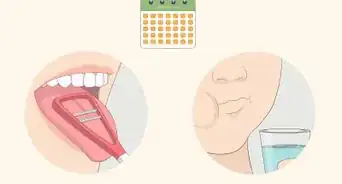
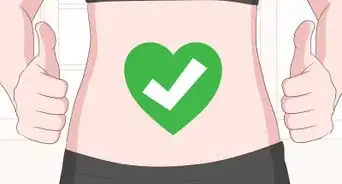
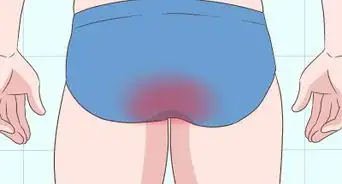
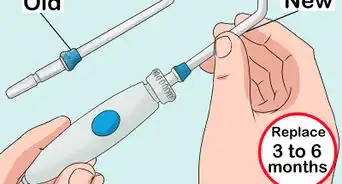
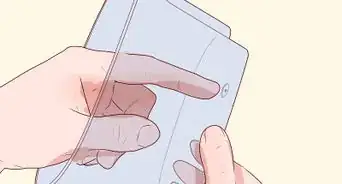
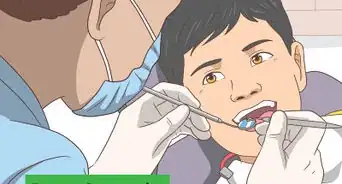












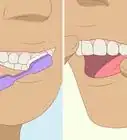




































Medical Disclaimer
The content of this article is not intended to be a substitute for professional medical advice, examination, diagnosis, or treatment. You should always contact your doctor or other qualified healthcare professional before starting, changing, or stopping any kind of health treatment.
Read More...